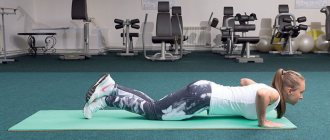The breathing process is incredibly complex. Many organs are involved, even the skin and digestive tract. Although they account for only 1–2% of all gas exchange. The main metabolism occurs in the tissues, and knowing this allows you to understand how to breathe correctly when running.
Inhalation and exhalation, knowledge of the correct combination of these processes allows you to understand how to breathe correctly when running
Inhalation - exhalation or how we breathe
We will analyze in detail how to breathe while running, but first you need to familiarize yourself with the most complex process - breathing. So, you were born and your first breath was exactly like this...
We take a breath and subsequent processes allow us to saturate our body with oxygen
The brain sends the signal “inhale” and a stream of air enters our nose. The air enters the nostrils and then into the nasal passages. Our nose is not only a visible part on the face, it is a complex organ responsible for breathing and some additional functions. For example, it is responsible for the nasolacrimal duct and olfactory receptors. Thanks to our nose, it is warmed, cleansed and moisturized. After going through this complex procedure, the air flow descends into the trachea - a tube. The tracheal cavity inside is ciliated epithelium. The vibrations of its fibers allow you to retain and remove the smallest dust particles. But this does not completely clean the air. The final stage of purification is carried out by the bronchi and smaller airways - bronchioles. In addition to the ciliated epithelium, this organ has muscle fibers and mucous membranes. This ensures the removal of mucus, dust particles and germs.
And now the purified and warm air enters the alveoli, where it is humidified to 100%. During quiet breathing, part of the alveoli sleeps, waking up as needed. The alveoli can be “awakened” by an increased need for oxygen during physical activity or thin air. From the alveoli, air enters the lungs.
The lungs are the main respiratory organ. Depending on the use of their volume, deep and shallow breathing are distinguished. With shallow breathing, only respiratory air participates in gas exchange. With deep breathing, reserves open - additional air received during maximum inhalation, and residual air released during maximum exhalation.
This photo shows a schematic representation of the process of air intake and exchange of oxygen and carbon dioxide
Respiratory movement is responsible for the flow of air into the lungs. Thus, the breathing movement itself is an integral part of the breathing process. The diaphragm and intercostal muscles are responsible for this mechanism.
Externally, this is manifested by a lack of movement in the chest. Breathing can be tracked by the movement of the abdomen.
The diaphragm separates the thoracic space from the abdominal space and is responsible for creating positive pressure in the abdominal cavity and negative pressure in the thoracic cavity. The diaphragm consists of 2 domes facing the lungs. Now you know what path oxygen takes to get only to the lungs, and this is not the final path, then it goes through the bloodstream to tissues and organs, but this process is quite well described in human physiology textbooks, which can be found on the Internet without any trouble. test your knowledge of physics and chemistry, but now back to how to breathe correctly while running.
Why is it important to monitor your breathing?
Breathing is an important part of any exercise, not just running. After all, without oxygen, muscles switch to anaerobic glycolysis mode, which significantly reduces their endurance and reduces the effectiveness of exercise. Breath:
- Provides the entire body with oxygen.
- Ensures normal functioning of the brain, which is responsible for coordination.
- Reduces the stress factor of running, which reduces the catabolic factor.
- Helps with fat burning, because complete fats can only be oxidized with a large amount of oxygen.
- Helps get rid of excess glycogen in the liver and increase the overall duration of your run.
- Helps control the pulse: the deeper and more uniform the breathing, the smaller it is. Shallow, rapid mouth breathing, on the contrary, helps accelerate your heart muscle.
That is why it is important to monitor your breathing technique not only when running, but also during basic exercises.
Basic rules for breathing when running
Absolutely all professional athletes know how important it is to breathe correctly during training; knowing how to breathe while running is an important preparation in the training process in all sports: running, throwing, pushing, swimming. That's right - this means breathing so as not to lose the rhythm, without interrupting during exercise to catch your breath. Every cell of the body must have time to be saturated with oxygen. When running, it is very important to learn how to breathe correctly.
Shortness of breath after running or while running is a clear example that your breathing technique is poor. If you are physically healthy, then shortness of breath should not bother you; you should go to the doctor and have your respiratory system checked.
This problem often occurs among smokers; the concept of “weak breathing” will haunt them even after they quit smoking.
Indicative position of a person with shortness of breath after running
Why does my side hurt when running and what to do about it?
When running, pain may appear in the left or right side. The pain itself is not something critical; there may be several reasons for its occurrence:
- Weak endurance, poor warm-up. Pain in this case means the accumulation of excess blood in the liver/spleen, which, under pressure (from the lowering of the diaphragm when inhaling), causes pain. That is why you need to increase the pace and duration of training gradually. A good warm-up is also necessary not only for the joints, but for the cardiovascular system. If you have such pain at the beginning of training, you need to slow down, start walking and breathe deeply and slowly.
- The cause may also be too frequent shallow breathing, for example according to the 1-1 scheme during low- and moderate-intensity running. All you need to do is breathe more deeply and measuredly.
- Recent meal. The stomach presses on the diaphragm, and it presses on the lungs. If you have eaten heavily, you need a break of at least 1.5-2 hours.
- Chronic diseases of internal organs. For example, this can happen with hepatitis. Only a timely examination (for example, an ultrasound of the abdominal cavity before starting running training) and consultation with a doctor will help here.
What can breathing be like?
There are several breathing techniques that will help you formulate rules on how to breathe correctly while running. Let's try to get to know them in more detail.
The most ideal and correct breathing option when running is breathing through the nose (nasal breathing). Yes, with strong oncoming air currents, sometimes this is not so easy to do. For many beginners, this may seem impossible. But you need to try and learn, since the oxygen passing through the nose has time to be cleansed, gain temperature and become moisturized before entering the lungs.
Proper breathing while running will create the right amount of oxygen in the body.
The most suitable breathing option for beginners and sprinters is called mixed breathing. This means that while running, you will inhale air through your nose and exhale through your mouth. This is also quite correct. After all, as is already known, oxygen passing through the nasal cavity has time to warm up, purify itself, and become more hydrated. At the same time, the high speed when exhaling through the mouth ensures the rapid release of carbon dioxide from the lungs, thereby making room for the next sip of oxygen.
If your breathing is short while running, the last meters of the distance will be very difficult.
Proper breathing during warm-up
Even if you are new to running, you probably know that the highest quality training becomes possible only after doing a warm-up.
Thanks to exercise, you prepare your muscles for the upcoming load and protect yourself from sprains and dislocations.
And so that preparing for running does not take a lot of strength and energy from you, start breathing correctly already during the warm-up.
Remember the main rule: inhale when the chest expands, and exhale when it contracts. Simply put, when starting any exercise, inhale, at the final stage, exhale.
Alternatively, your warm-up could look like this:
- Squats: squat - inhale! Stand up straight and - exhale! (yes, that’s right, and not the other way around, this is not a typo, this is a small feature of runners’ training).
- Bend to the side: take in more air into your lungs, bend over, exhale! The same thing with lunges and swings - you need to exhale at the end point of the exercise.
- Push-ups: here you need to inhale with minimal tension, and exhale with increased tension. Bend your arms - inhale, straighten your arms - exhale.
It's that simple! The main thing is to never hold your breath when your muscles are as tense as possible. Lack of oxygen can lead to increased blood pressure and sometimes even loss of consciousness.
Train your breathing muscles
Just as we do stretches or hamstrings to strengthen our legs, we can also strengthen the muscles we use when we breathe.
In fact, researchers at the Center for Sports Medicine and Human Performance, located at Brunel University in England, have shown a direct link between the strength of your diaphragm and fatigue during exercise.
The easiest way to learn to breathe correctly is to start from a lying position. Lie on your back, try to breathe as deeply as possible, so that with each inhalation your stomach rises as much as possible and completely relaxes (falls down) when you exhale. Continue practicing this exercise until you feel you can do it in an upright position.
Once you have mastered this technique, you can move on to Pilates exercises. This set of exercises will help stretch the muscles of the chest and strengthen the spine, which will subsequently have a positive effect on your breathing while running.
Breathing rhythm
Your exact breathing pattern will depend on how hard you work and/or the intensity of your workout.
Your breathing rhythm is related to the tempo of your running steps.
For example, a 2:2 rhythm means you take two steps (right and then left foot) as you inhale, and two steps (again, right and left foot) as you exhale.
Easy running
As a general rule, a 3:3 rhythm (three steps - left, then right, then left again as you inhale) is best for warming up and running at an easy pace. This allows you to take in more oxygen into your lungs and then exhale it with relative ease.
Don't try to force yourself to breathe in a 3:3 rhythm during a fasting day if you don't feel comfortable. Remember that the purpose of such a day is to help your body recover. If the 2:2 rhythm (discussed above) suits you better, continue with it.
Breathing at a rate slower than 3:3 is not recommended because your body does not have time to remove carbon dioxide. When running at an average pace, a person should take 180 steps per minute (some a little more or less), which means you take 90 steps with each leg for one minute. The 3:3 rhythm allows you to take about 30 breaths per minute, this is enough time to process carbon dioxide and at the same time get the amount of oxygen you need.
Running at a moderate pace
This pace is a little more difficult than the previous one, but it does not involve a large amount of effort, as a rule, it is performed in a 2:2 ratio. The 2:2 breathing rhythm allows for approximately 45 breaths per minute, ideal for steady pace running and marathon running.
Challenging training and running competition
After finishing a race or a particularly challenging interval workout, breathing in a 2:2 rhythm won't do. In this case, you can switch to a 1:2 rhythm (one step inhale, two steps exhale) or 2:1 (two steps inhale, one step exhale). This will help increase your oxygen consumption to 60 breaths per minute.
I do not recommend a 1:1 breathing rhythm. At this pace, you will take shallow breaths and will not be able to absorb the amount of oxygen needed to maintain proper ventilation in your lungs.
In my personal experience, I tend to not pay attention to my breathing rhythm at the end of a competition. I prefer to just run, focusing on the running itself, and my breathing automatically adjusts to the desired rhythm. However, a special breathing pattern can be beneficial for those runners who feel particularly tense in the last few meters before the finish line.
Other beneficial types of breathing rhythms
While specific breathing rhythms can help you determine and control the intensity of your running, you can also use them during other running workouts and competitions.
Tempo control
Paying close attention to your breathing rhythm will help you control and “feel” your pace, especially during running and interval training. Once you've found the right pace for your workout, you can monitor when you start to breathe faster or slower so you can immediately spot when you're accidentally drifting off your pace. This requires close attention to detail, but can also help those runners who struggle to maintain a consistent pace.
You can't outrun yourself. How to run correctly
Despite the fact that at first glance running seems like an ordinary sport, productive running training requires theoretical knowledge of its fundamentals, which will be discussed now.
Running technique
The correct position of the body and the placement of the foot while running will eliminate the occurrence of sprains, fractures and other injuries characteristic of running, and also allows the runner to expend less strength and energy.
The body should be level or slightly tilted forward. The main mistake of all beginners is when the body falls back, thereby complicating running by gravity. Shoulders should be lowered and relaxed. When they are tense, excess energy is spent.
There are several basic ways to place the foot: only on the toe, on the full foot, rolling from heel to toe and from toe to the full foot. The choice of foot placement method depends on the distance, running time and physical characteristics of the runner.
Attention!
The heel-to-toe technique is considered suitable for beginners, as it is the simplest of all. But when using this technique, you should choose the right and comfortable shoes to protect yourself from damage and ensure a comfortable run.
When running long distances, the most effective is considered to be placing the foot from the toe to the full foot; for short distances, placing the foot on the toe, but this technique is quite complex, so it is mainly used by professionals.
The most difficult thing is running on a full foot; due to its specific nature, it is fraught with serious injuries.
Breathing Basics
Firstly, it must occur with both the nose and mouth at the same time.
When breathing through the nose, oxygen is absorbed better, but it is worth considering that to breathe through one nose you need to have well-developed nasal breathing, and the amount of air entering through the nose may not be enough when running fast and under heavy load.
And when breathing occurs both through the nose and through the mouth, the body is replenished with both easily digestible oxygen and that which is more difficult to digest, which guarantees the full functioning of the body.
Thirdly, you need to remember about breathing from the very beginning, because with uncontrolled respiration you can start suffocating already halfway through.
Time and place
Beginners should not run a lot at once; it is advisable to gradually increase the load. During the first months you can run every other day; about half an hour will be enough. Determining the right time of day for jogging is based on your chronotype, taking into account when activity is at its peak.
If you are a morning person, morning is more suitable for you, if you are a night owl, evening is more suitable.
You can also run during the day, but in the warm season it is usually very hot during the day, so it is better to think twice before exposing your body to high temperatures, which, combined with physical activity, will adversely affect the body.
Another important part of running training is the location. It is allowed to run on the ground, asphalt, grass, sand, or at the stadium on specialized tracks
A good option is to periodically change the terrain. This allows you to use additional muscle groups, since their involvement in the work can vary depending on the complexity of the selected surface.
The main thing is to remember that any type of physical activity should bring only benefit and pleasure.
Andrey, www.vitamarg.com











